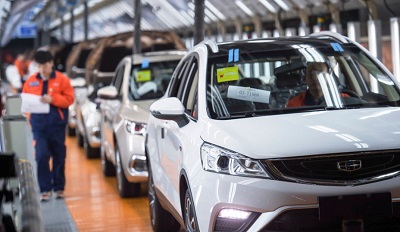
文 | 谢祖墀
2022-2-23
本文是高风咨询CEO谢祖墀博士撰写的文章,此文于2022年2月23日发表在香港《灼见名家》网站。原文英文版于2月8日发表在高风微信公众号。展望未来,中国不仅将引领着跨国公司的商业战略思考和部署,它亦将会主导他们在组织和领导力方面的重塑。
在一个百年未有之大变局的时代中,一些前所未有的干扰及问题, 如新冠肺炎疫情、气候变化、地缘政治、数字经济和数字鸿沟,以及全球化与去全球化之间的拉锯战等,正在严重地影响着全世界。
特别是世界经济格局也发生了重大的变化。大约40年前,相对于与当时毫无疑问是世界遥遥领先的经济体美国相比,中国的GDP可以说是微不足道。今天,中国的GDP已经占有全球总数的大约15%,紧随美国之后。全球经济力量结构上的重大变化为中国发展带来了新的契机,也带来前所未有的未知挑战。
中国汽车行业正快速更迭
汽车行业是一个展示未来可能发展的好例子。中国的汽车行业正在快速更迭的过程中变得智能、互联互通、电动化以及自动化。这意味着软件和电子零部件正成为汽车愈来愈重要的组成部分,而他们的产品生命周期亦正在变得愈来愈短。与此同时,新产品和技术所须的资本投入亦正在大幅增加。
中国是世界上最大的汽车市场,同时也是一个庞大的数字经济体。中国政府鼓励推动新能源汽车的发展,使中国成为了全球汽车行业创新与变革的中心。2021年中国汽车总销售量同比增长3.8%,达到了2628万台。其中新能源汽车的销售量达到了450万台,几乎达到了总销售量的六分之一,并占全球新能源汽车销售总量的50%以上。
随着中国的数字经济的持续发展,智能和互联互通的的交通工具变得愈来愈普遍。而中国的自动驾驶技术方面亦随着世界领先的软件和硬件企业的参与,正在取得可观的进展。这一进展得益于不少中国城市正在建设的数字基础设施,这亦是中国推出智慧城市计划的一部分。
一系列新的新能源汽车玩家已经开始出现,这其中包括国有企业和民营企业。央企如一汽、长安,以及地方国企如上汽、广汽都已进入了新能源汽车领域。其中,广汽集团已经宣布它的电动汽车子公司广汽埃安将会独立运营。民营企业也正在积极参与到新能源汽车市场的竞争中,包括例如吉利、长城、比亚迪、奇瑞等汽车公司。
近10年内创立的电动汽车初创企业,例如小鹏、蔚来、理想等「造车新势力」已经在市场上开辟了新的道路,确定了自己的身份和定位。除此之外,华为、百度、小米这些科技公司也正在参与到这个市场中来。
创新者,而非模仿者
在过去十多年中,中国已经从一个「山寨大国」发展为一个创新型的经济体。透过利用移动互联网作为平台,许多中国科技公司创造了新的数字商业模式来解决了不少社会中的痛点问题。这些公司如阿里巴巴、腾讯、小米、字节跳动、京东、拼多多等,在这段时间都实现了飞速增长,并形成了大型的平台公司。
与此同时,「硬科技」行业的公司如华为、中芯国际、大疆创新、商汤科技、科大讯飞等也以自己的方式为中国的改革创新做出了重大贡献。
这些公司的增长往往遵循着一定的规律。当这些公司的创始人或高管看到其他创业者的成功例子时,他们经常会问「为什么不是我?」「如果别人能成功,为什么我不能?」在这些企业家的领导下,这些公司,尤其是在创业期间,往往能够快速、敏捷的适应市场变化。
他们一般并不介意把他们的想法投入市场做实验,特别是对于消费互联网领域的企业来说经常更是这样。他们俨然都有一种大无畏的精神。
如果我们从近距离观察那些具有代表性的中国民营汽车公司的领导者,我们会发现他们都具有一些类似的特质。这些企业家都是连续创业者,他们不害怕承担风险,在面对多变的环境的时候,他们可以迅速地调整经营策略和敏捷应对市场变化。他们一方面具有竞争的特质,同时亦可以在必要的时候与他人合作。
适时、连续的跳跃战略
企业战略背后的概念在随着时间的推移而发展。30年前,企业高管、咨询公司和学者们喜欢讨论在「多元化」(建立庞大但通常互不相关的业务组合)和「聚焦」(透过公司自己的「核心竞争力」,只在自己的优势领域内经营)之间的比较和取舍。从那时开始,「基于核心竞争力或能力」的战略便成为了商业世界中的主流战略框架,指导着许多大型企业高层们如何做出战略决策,以及支配着资本市场如何衡量公司的价值。
这两个概念都不能完全解释中国企业(和一些美国西岸领先的科技公司)的快速增长,特别是对于那些于2000年代后期,透过使用消费互联网作为平台高速发展起来的一些企业。
在2014年,我提出了一个新的战略框架:即使公司缺乏所有必要的全部能力,他们仍然可以通过「适时、连续的跳跃」,从现有的情况跳跃而获得新的机会。采用这种战略的企业领导层需要经常评估新机会带来的吸引力,对比他们当前的能力。尽管往往企业当前的能力未必能够足以应付新业务中的需要,企业决策者会作出跳或不跳的决定。尽管能力有所不足,不少企业都会从原有的领域跳进新的领域中,然后尽快弥补中间的能力差距。
弥补能力差距可以通过企业的自身建立,亦可通过从与合作伙伴合作中获取,后者即今天许多人所讲的「生态系统」。我称这种战略思考方式为「战略第3条路」,它可以弥补前面提到的两个原有战略框架之间的理论不足之处。因此也可以说,商业生态系统是「第3条路」战略的组织体现。换言之,商业生态系统创建的基本需求,是出于公司在跳跃时希望尽快弥补能力空缺的原因。
通过这种适时、连续的跳跃战略,很多中国的企业,特别是一些互联网企业,通过利用了移动互联网,在有合适时机的时候完成了从一个机会跳到另一个机会的跃进。今天,他们所依赖的科技已经变成人工智能、物联网、5G、区块链和云计算等前沿的科技。放松管制催生新的企业错综关系
中国政府将科技创新作为「十四五」规划的核心。汽车就是有代表性的行业。可以想像,未来中国许多行业将会出现更多颠覆性的变化。
自2022年1月1日起,中国政府取消了所有在中国汽车整车领域对外资的限制。在过去的30多年中,外资汽车生产商必须以合资的形式在中国市场经营,而且外资持股比例不能超过50%。许多评论者在过去一段较长时间中却不断假定在这些中外合资企业中,重要的价值贡献者是外资,而中资大部分只是在占着便宜而已。
但是在这个规定取消之后,外资汽车公司并没有大量取消或调整他们与中方的合资关系,从而建立自己的独资业务,反而是马上出现了许多不同企业与企业之间的新的错综关系。
这些关系包括了多个中国国有企业,民营企业和外国公司的不同排列组合。除了汽车生产商,其他参与者如零部件供应商和软体设计公司也有所参与。这些企业之间的错综关系意味着在新时代竞争需要更多和更新的能力和创造力,而汽车行业的格局将会被进一步颠覆。
作为智慧城市发展计划的一部分,数字和智能的基础设施正在快速和大量兴建。这些建设让更先进设计的新一代汽车以及其他关键零部件如电池等的实现变为更有可能。从更为宏观的角度来看,全球汽车行业正在走向「一个世界,两个系统」(One World, Two Systems),这两个系统的中心分别是中国和美国(或西方世界)。
中国正在塑造跨国企业的组织与领导力
而对着中国的改变与成长,西方跨国公司也不断地在进行反思。最初,他们一般会把他们在其他国家的产品或商业模式复制到中国来,认为这样做便能足够获取中国市场的机会。在某些情况下,这样的做法是可以达到某种程度的目的的。
但在过去20、30年间,中国的政策和社会环境经历了多次的更迭,中国和中国企业已经变得更有创新能力,而在华经营的外国跨国公司通常反而对不断变化的科技创新和商业环境反应较为缓慢。这主要是由于他们自己对中国的观察、理解和内在化的认知能力有所不足所致。
今天,大部分(如果不是全部)在华经营的的跨国公司已经明白并认识到改变的必要性,但他们常常由于多年累积下来的组织惯性不能完全或及时作出适当的改变。但是为了面对环境的改变,他们必须进行调整,能够实现这种改变的领导层变得更加举足轻重。跨国公司要做的是,要了解自己需要改变什么以及如何领导和管理这些改变──不论是在思维方式、战略制定、推动创新,还是在预测消费者或客户偏好等多个方面。
随着中国从「标准追随者」到「标准制定者」身份的转变,不少跨国公司亦已意识到他们的改变需要从更深的层次中思考和着手。中国正从4个方面开始制定新标准。第一是技术协议的设置,主要在5G的部署上体现。第二是创造新颖的商业模型。应用程式TikTok(抖音海外版)就是一个很好的例子,它彻底颠覆了短视频App领域。在2021年,TikTok超越了谷歌成为世界上最多访问的网站。第三方面是中国建立的新的产业赛道,并进行颠覆,例如新能源汽车。第四,中国推出的中央银行数字货币(CBDC)的开创性应用将会对中国以及全球金融产生重大影响。
大多数跨国公司的中国组织都是以前建立的,这其中包括架构、人事、能力、系统和流程,以及企业文化和风格。当时中国的整体情况往往与今天的已经有了很大的改变。每一家跨国公司都需要检验以上这些元素是否仍然适用于今天的新时代。毕竟,中国的振兴不仅仅是技术性质和递增式发展而已,它是凭借着中国悠久而丰富,且具包容性的文明、文化与历史,同时它也是变革性的。
展望未来,中国不仅将引领着跨国公司的商业战略思考和部署,它亦将会主导他们在组织和领导力方面的重塑。


